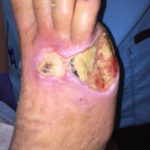I have decided to start a series called the “Peripheral Arterial Disease Hall of Shame.” Maybe if we keep talking about these cases we can change the way these patients are treated so they are diagnosed before it is too late.
This is a 60ish year old man with poorly controlled diabetes (A1 > 9) who had developed purple changes of the right 5th toe 4 weeks earlier. He went to the ER complaining of foot pain and was diagnosed with cellulitis, given antibiotics and sent home. On his visit to the Wound Clinic 2 weeks later, the right 5th toe was dead, his entire foot was ischemic and he was in excruciating pain that prevented sleep. His Skin Perfusion Pressure (SPP) was only 19 mmHg and is pulse volume recording was flat. We admitted him emergently and an angioplasty was performed the following day, followed by a 5th ray amputation. Tendons became exposed on the foot.
He developed cardiac ischemia and required a cardiac bypass but had a complicated course, surviving on extracorporeal membrane oxygenation. A skin graft was placed over the exposed tendons, much of which mummified. However, over many weeks, the failed graft sloughed and revealed a healed foot.
The reason this case is in my “Peripheral Arterial Disease Hall of Shame” is that his early ischemic changes and cardiac disease were not diagnosed months earlier at a famous institution in California, nor did our ER physician recognize acute ischemic changes when he presented with rest pain. If he had presented to the ER with chest pain, he would not have been sent home, but his critical limb ischemia went unrecognized. Why is this hard?
Photo 1: Note the advanced ischemia on his first visit. He has ischemic rubor of the foot.
Photo 2: Even after revascularization, the ischemic dorsal foot broke down.
Photo 3: Months later, after a complicated course including a CABG. He’s lucky to be alive.

Here’s a link to an article about using SPP for vascular screening, from Today’s Wound Clinic:
http://www.todayswoundclinic.com/articles/addressing-need-noninvasive-vascular-testing-outpatient-clinic-case-study
Caroline Fife, MD Twitter | Facebook | LinkedIn

Dr. Fife is a world renowned wound care physician dedicated to improving patient outcomes through quality driven care. Please visit my blog at CarolineFifeMD.com and my Youtube channel at https://www.youtube.com/c/carolinefifemd/videos
The opinions, comments, and content expressed or implied in my statements are solely my own and do not necessarily reflect the position or views of Intellicure or any of the boards on which I serve.




